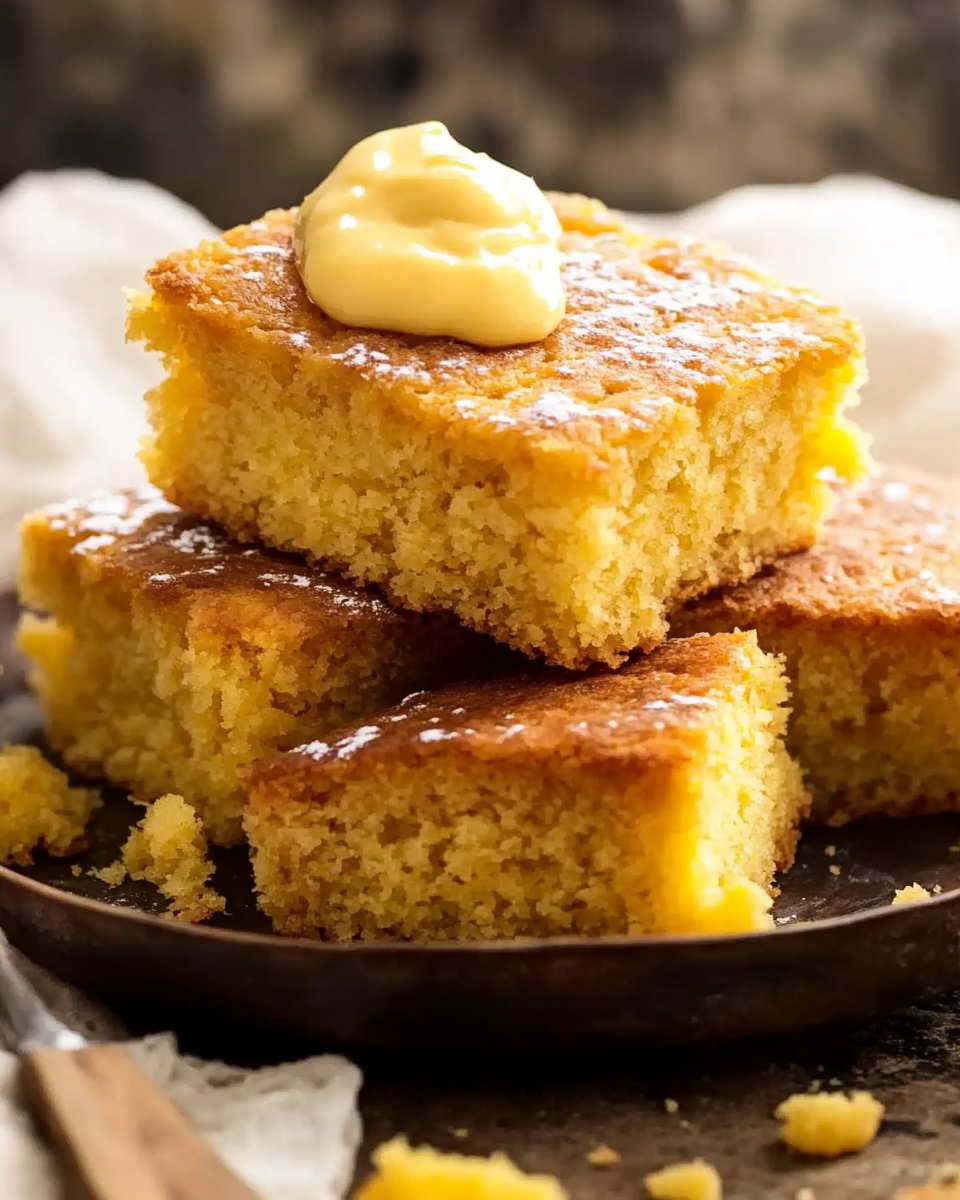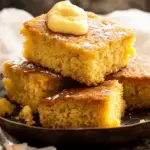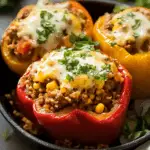Cornbread is the perfect addition to any meal, with its soft and fluffy texture paired with a slightly sweet flavor. The golden crust and buttery finish make it a comforting classic that never fails to impress. Whether served alongside chili, roasted meats, or as a standalone snack, this cornbread will always be a crowd-pleaser.
Making cornbread is easy, and it can be customized to your taste. You can add in extras like cheese, jalapeños, or herbs to make it even more special. It’s a great side dish for family meals, holiday feasts, or just to enjoy with a cup of tea. Simple yet satisfying, cornbread is a staple in Southern cuisine and beyond.
Full Recipe:
-
1 cup cornmeal
-
1 cup all-purpose flour
-
1/4 cup sugar
-
1 tablespoon baking powder
-
1/2 teaspoon salt
-
1 cup milk
-
2 eggs
-
1/4 cup unsalted butter, melted
-
1/4 cup vegetable oil
Directions:
-
Preheat oven to 400°F (200°C). Grease an 8-inch square baking pan or a similar-sized pan.
-
In a large bowl, combine cornmeal, flour, sugar, baking powder, and salt.
-
In a separate bowl, whisk together the milk, eggs, melted butter, and vegetable oil.
-
Pour the wet ingredients into the dry ingredients and stir until just combined. Be careful not to overmix.
-
Pour the batter into the prepared pan, spreading it evenly.
-
Bake for 20-25 minutes or until the top is golden brown and a toothpick inserted into the center comes out clean.
-
Let cool slightly before serving.
Prep Time: 10 minutes | Cooking Time: 25 minutes | Total Time: 35 minutes
Kcal: 230 kcal | Servings: 9 servings
The History of Cornbread
Cornbread has a rich and storied history, deeply rooted in Southern cuisine and American culture. It originated with Native American tribes, who used ground corn to create a variety of dishes. Corn was a staple in their diet, and they taught early European settlers how to use it in various forms, including as a basic bread. Over time, cornbread became a popular food for settlers across the United States, particularly in the South, where corn was abundant.
Cornbread is often associated with the flavors and traditions of the Southern United States, but it has evolved in different regions and cultures. For example, in the North, cornbread is often made with a sweeter taste, while Southern cornbread tends to be more savory. Despite regional variations, cornbread remains a beloved and iconic dish in many American households, especially during the fall and winter months.
The Basics of Making Cornbread
Making cornbread is surprisingly simple. The basic ingredients include cornmeal, flour, eggs, milk, sugar, and fat (such as butter or oil). These ingredients come together to form a light, fluffy, and slightly sweet or savory bread that can be baked in a variety of ways. Whether baked in a skillet, a pan, or a muffin tin, cornbread is versatile and can be served with countless meals.
The key to making the perfect cornbread lies in the ratio of cornmeal to flour, as well as the type of fat used. For a rich, buttery taste, many people prefer to use butter, while vegetable oil can make the bread slightly lighter. The texture of cornbread is often a balancing act—some people like it dense and moist, while others prefer it crumbly and light.
Regional Variations of Cornbread
Cornbread varies significantly across the United States, and each region has its own take on this classic dish. Below are some popular regional variations of cornbread:
-
Southern Cornbread: Southern cornbread is known for being slightly more savory. It typically does not contain sugar, making it a perfect accompaniment to chili, greens, and other hearty dishes. Many people in the South swear by cooking their cornbread in a well-seasoned cast-iron skillet, which gives it a crispy, golden crust.
-
Northern Cornbread: In the North, cornbread tends to be sweeter, with more sugar or honey added to the batter. It’s often lighter and fluffier compared to its Southern counterpart. This variation is great when served as a breakfast bread or as a side with stews and soups.
-
Mexican Cornbread: This variation incorporates ingredients like jalapeños, cheese, and sometimes corn kernels for an added burst of flavor. It’s a wonderful dish to serve at barbecues or alongside Mexican dishes like chili con carne.
-
Hot Water Cornbread: A staple in the African American culinary tradition, hot water cornbread is made by mixing cornmeal with hot water and then frying the batter in oil. It’s denser and crispier than traditional baked cornbread and is often served as a side dish to soul food meals.
Tips for Making Perfect Cornbread
Achieving the perfect cornbread can be tricky if you’re not familiar with the nuances of the batter. Here are some helpful tips to ensure your cornbread comes out perfectly every time:
-
Use the Right Cornmeal: Opt for stone-ground cornmeal for a more authentic, rustic texture. It will give your cornbread a rich, hearty flavor compared to the finely ground cornmeal used in many boxed mixes.
-
Don’t Overmix: One of the most common mistakes when making cornbread is overmixing the batter. Overmixing can result in a dense, rubbery bread. Stir the ingredients together until just combined—lumps are perfectly fine.
-
Preheat the Pan: If you’re using a cast-iron skillet, preheat it before pouring in the batter. This will help create a golden, crispy crust on the bottom of the cornbread.
-
Add Mix-ins for Extra Flavor: You can customize your cornbread by adding extras such as shredded cheese, chopped herbs, diced peppers, or even crumbled bacon. These additions will bring new flavors and textures to the bread.
-
Use Buttermilk for Moisture: For a richer, creamier cornbread, consider substituting regular milk with buttermilk. The tangy flavor of the buttermilk pairs perfectly with the sweetness of the cornmeal, making it a great option for both savory and sweet cornbread recipes.
Serving Suggestions
Cornbread can be served in a variety of ways, depending on the meal. It pairs wonderfully with Southern dishes like fried chicken, collard greens, and gumbo. Its slightly sweet flavor makes it an excellent accompaniment to savory stews, chili, and soups. Here are a few serving ideas to consider:
-
With Chili: Cornbread and chili are a classic pairing. The warmth and spice of the chili complement the slightly sweet and savory flavors of the cornbread. Serve a slice of cornbread with a bowl of chili, and you’ll have a meal that’s perfect for chilly days.
-
As a Side to Barbecued Meats: Cornbread is a fantastic side dish for barbecued meats, such as ribs, pulled pork, or grilled chicken. Its light texture and buttery flavor are a great match for smoky, charred meat.
-
For Breakfast: Cornbread can even be served for breakfast. You can top it with butter and honey, jam, or fruit preserves for a comforting start to your day. If you’re feeling indulgent, add a dollop of whipped cream or a sprinkle of cinnamon sugar.
-
With Greens and Gravy: In many Southern households, cornbread is served alongside greens like collard greens, mustard greens, or turnip greens. The richness of the cornbread is a great contrast to the slightly bitter flavor of the greens, especially when topped with a little gravy.
-
As a Snack: Cornbread also makes a great snack on its own. You can enjoy it fresh from the oven, or you can toast it slightly and spread it with butter or cream cheese for an extra indulgence.
Conclusion
Cornbread is a beloved dish with deep historical roots and a place at many dining tables across the United States. From its humble beginnings as a Native American staple to its modern-day iterations in various regional cuisines, cornbread remains a versatile and comforting food. Whether you prefer your cornbread sweet or savory, with or without add-ins, there’s no wrong way to enjoy it.
By following a few simple tips, like using the right ingredients and avoiding overmixing, you can make cornbread that is light, fluffy, and full of flavor. With so many variations to try, you’ll never run out of creative ways to serve cornbread with your favorite meals. This timeless dish is more than just a side—it’s a piece of culinary history that continues to bring people together around the table.






